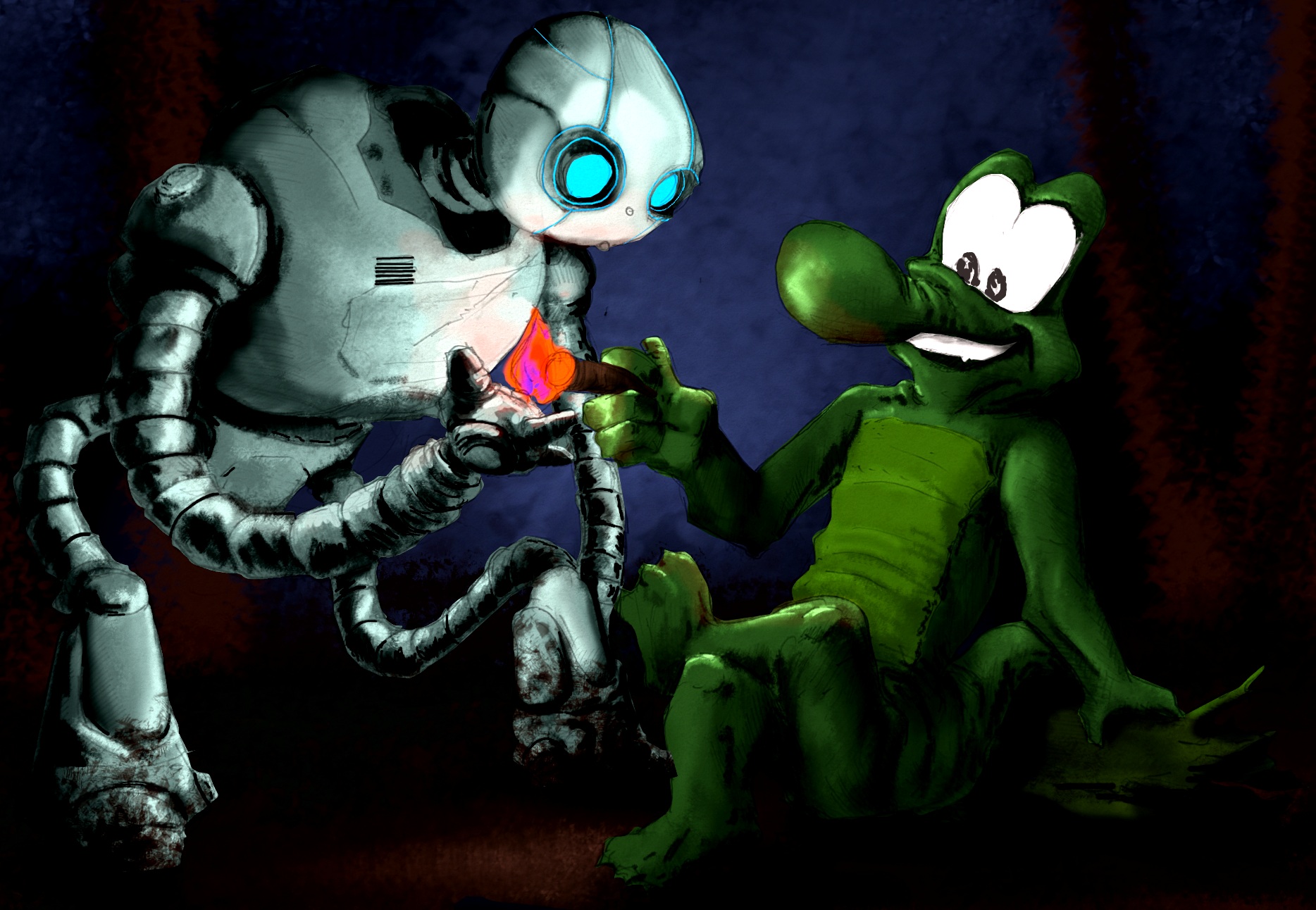Fred and Loathing on The Internet
Welcome to the public web log of Fred Lambuth

Popular Tracks from 2025-06-22
A Movie That Will Touch You Deep In The Kernel
2025-Jun-22
Contemporary enough material is what we have today: an animated feature from DreamWorks released within a year of this blog post’s publication. Wow, that's fresh! Hope that matters when this is (if?) read far in the future.
The other day I watched The Wild Robot. From what I can gather from my doom scrolling, this one was supposed to be a critics-and-awards darling. What drew me to the movie is the very fact that it is a big-budget Hollywood production dedicated to some mechanical lifeform, hopefully up to some thought-provoking hijinks made with dazzling animation.
That is what we have with The Wild Robot: A very decent movie. Not exactly great. Filled with some stunning images, sequences, story points, characters — all the parts that, when put together, make a well-crafted film worth remembering. I would say that this movie has droves of things to commend. However, it did not stir me as much as some other “teaching a robot how to love” movies I’ve seen. That particular movie type is one in which I have echelons of favorites.
I’m not the type to do numerical rankings. Separating films into the S/A/B tier of worth-remembering is something I can endorse — and practice. The Wild Robot is squarely good enough to get into the B class, which is nothing to sneeze at. This rating does get a bit specific because too many could qualify. This very idea of “teaching a robot how to love” is somewhat the original idea of all science fiction. I’m usually only concerned with teaching an actual robot how to love. Robots with steel, diodes, and magnets.
Frankenstein’s monster is not exactly a life form made of gears and transistors. It is a creation made of man, and not of nature. Hence the dash of irony that is the title The Wild Robot. Just how could a robot be wild? They come out of a factory! Or at least a lab. I do not want to think about just any ol’ artificially created being as part of this loose ranking. Too many films could get roped in.
Besides, the robot part is essential to my interests. I’m not interested in watching a movie about teaching a mad scientist’s fish monster how to love. Well… not especially. Not as much as if this creature originates from cold steel and cold logic, wired on infinitesimally small circuitry. The visual appeal is also a big part of it.
To a young me, robots were the most interesting thing an artist could conjure. Monsters of some type may be a close second. Whenever a monster demolished a city, the somewhat-relatably-human, engineered counterpoint to these monsters is what would interest me more than the kaiju. If a movie or TV show promised robots, I was hooked. The bigger the better! And with missiles! Or maybe some type of melee weapon — which makes no sense given the technology inherent in producing colossal artificial limbs, but looks cool!
Seeing robots now, big or small, interests me not because of the mere sight of anthropomorphized machines, but because of the storytelling chances. I’m just keenly curious to see how the writers are going to handle this now well-worn subject. The questions involved in how to teach a remote, unfeeling object a lesson on “how to love” are almost half of the reasons for pursuing philosophy. The more I think about it, this plotline is one of the essential story archetypes — right up there with Redemption and Resurrection. In this case we’re Rehabilitating somebody for human life. Not a child or prisoner, but a new participant to humanity.
Given those expectations, The Wild Robot has a lot to meet. It does not go that far. It’s no Terminator 2! It’s a fine movie that does a solid job showing the audience the process of a service-oriented application changing into a living member of a natural ecosystem. I would say a lot of this movie’s merits fall in strong visual storytelling that brought me right into the movie’s world immediately. The latter half of the movie delved into a lot more talking than doing — especially a lot of talking from an unseen villain that rolls into effect almost entirely in the third act.
Keeping to my rules of “show, not tell” would be difficult to do and still have enough plot points to fill out a ninety-minute runtime. The first half of the movie nearly meets all the requirements I would have for a solid film. The visual storytelling is there in droves, doing the work of a story that has voice acting but reserves dialogue mostly to a fox character that assists the protagonist robot in performing the parental task it has been self-assigned. That is not to say there is a lack of voices acting talent— there are plenty on display. Once again, skilled ones that do a standout job — except for the fox.
I learned later that Pedro Pascal played the part. He either made acting choices I do not understand, or he made no acting choices and delivered one of the most bland voice jobs I’ve heard in a while. I’ve seen him act — usually he’s on the money. I do not know just what type of character I was supposed to discern from the fox’s voice acting, or even from the script. This fox was not especially wily. He was dastardly, but I got the feeling that it was a theme directed at all of nature, not just an egg-stealing fox. The robot was learning the cruelty of nature from all the animals, not just a fox willing to eat the younglings of other animals on the island. The fox often stated flatly that he was the most hated animal in the forest. Once again, most animals shown in the movie were contenders for that role. Just what was this fox’s deal?
I found the possums to be the funniest section of animals giving brutal lessons about nature to the main character. The children and mother mixed macabre and everyday quite well.
This superbly made first half would have resulted in a fabulous animated short. It would be lacking in the kind of conclusion one would expect in a kid-oriented, big-budget Hollywood animated movie. A conclusion was certainly delivered, but in a way that makes me wonder how much was shoved into a simple story of a robot mothering a goose — or how much was crafted out but had to be cut for one reason or another.
This second-half-only villain is part of a greater human world that is touched upon in some scenes. The ‘wild’ robot protagonist’s rehabilitation with the human-made industrial base that spawned it is a part of the story, yet nothing about this process or the repercussions involved is talked about. Even though it does look like a positive message, rather than a dour one painting the humans as careless with nature. Instead the movie’s end gave glimpses of a techno-driven utopia of self-contained agriculture that does not bother Earth’s natural rhythms.
All the techno visuals to this story set in a somewhat far-off future were definitely animated smoothly. A clean, white-ish 2000s Apple-products look that still gives me sensations of optimism. The main character itself leaned into the old-fashioned but reliable bendy-arm design of fictional robots. I’m not aware of the actual chances of this being a reliable means to develop mechanical limbs — it is an almost carte-blanche scenario for an imaginative artist.
I hope that there was, in fact, much more lurking behind the scenes in this second half of this movie. Maybe for the sake of a sequel. There is rarely any necessity for a sequel to a well-crafted movie. In this case, I hope there were fleshed-out ideas about how this visually hopeful human society we catch brief looks of could create a villain that has taken its programmed directives too literally. My guess would be medium-term myopia — a case of scientifically driven humans thinking they’re in charge but actually manipulated by an artificial mind with an agenda hard to see within one human generation. Well, that’s how I would have written it.

eddie_from_chicago
Does that mean you wanna watch this one?
2025-09-13 23:26:22.719465
ariggs
I liked this post :)
2025-06-25 19:18:01.876435